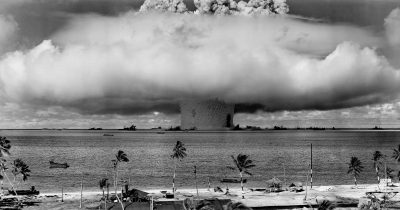By
Tom Arms
Hands up everyone who has heard of Hiroshima. Ah yes, a goodly number. How about Nagasaki? Not quite as many, but not bad.
Now hands up all those who have heard of the Marshall Islands. Let’s see—one, two, hmm, not very many.
How about how many have heard the word bikini. Yes, much more reassuring.
The skimpy two piece swimsuit was given its name by its French designer Louis Reard because he hoped its eye-popping design would create “an explosive commercial and cultural reaction”, similar to the nuclear bombs that the United States dropped on Bikini Atoll during the Cold War.
An atoll, by the way, is an idyllic ring-shaped coral based island with a lagoon in the middle. The sort of place you want to be shipwrecked, with either George Clooney or Catherine Zeta-Jones, dependent on your gender.
Bikini atoll is one of many in two parallel chains of Islands covering 750,000 square miles in the South Pacific. The islands are called the Marshall Islands. After World War Two, the United States was given responsibility for administering the islands and looking after the welfare of its inhabitants. Between 1946 and 1958 it did this by exploding 67 nuclear devices on Bikini Atoll and other parts of the Marshall Islands. Over the 12-year period the United States exploded the equivalent of 200 kilotons a day. The bomb dropped on Hiroshima was 15 kilotons.
Not surprisingly, Bikini Atoll is now uninhabitable. Also not surprisingly the Marshall Islanders suffer one of the highest rates of cancer and radiation-related birth defects in the world. The United States government provides military protection but not a single oncologist.
Monday—the 7th of March—is the 70th anniversary of the day that the inhabitants of Bikini Atoll were evacuated from their home in preparation for the first nuclear test. It is also the day that the tiny Marshall Islands (population 52,634) takes the world nuclear powers to the International Court of Justice at the Hague for breaching the Nuclear Non-Proliferation Treaty.
The argument of Foreign Minister Tony de Brum is that the 1968 Treaty does more than commit nuclear weapons states to preventing the spread of nuclear weapons. Article Six says they are obligated to “pursue negotiations in good faith on effective measures relating to cessation of the nuclear arms race at an early date and to nuclear disarmament, and on a treaty on general and complete disarmament under strict and effective international control.”
ABM, SALT One and SALT Two did a reasonable job of limiting the growth of nuclear weapons and STARTs One, Two and Three resulted in pretty big cuts in Russian and American nuclear arsenals. But the world is still a long way from the stated aim of nuclear disarmament.
Let me make it clear that I am not a sandal-wearing ban the bomb activist. I argue that not once in the course of human history has anyone successfully stuffed the technology genie back into the bottle. Therefore the best defense against nuclear attack—in fact, against any attack—is the possession of nuclear weapons.
BUT—and it is a big BUT– does the world really need 15,000 nuclear warheads; 7,200 of which are held by the United States and 7,500 by Russia. Any one of the existing warheads could burn to a crisp every inhabitant of New York City or Moscow, turn hundreds of square miles into a nuclear desert for generations to come and create a nuclear fall-out with incalculable consequences. To protect ourselves, do we really need to be able to do that 7,200 times over?
The Marshall Islands don’t have a snowball’s chance in a nuclear winter of winning their case. And they know it. For one thing, Washington doesn’t accept the jurisdiction of the International Court of Justice which could be the subject of a future Observation.
But this tiny island nation—whose highest point is seven feet above sea level– is to be applauded for using the legacy of their sad and unique Cold War experience to plant their flag firmly on the moral high ground.
Tom Arms broadcasts on world affairs for a number of US radio stations including WTKF at http://www.wtkf107.com/. His Weekly Viewpoints discussion programme can be heard at 1830 EST on Wednesdays and his LookAhead at the next week’s main events on Fridays at 1800.
LookAhead Radio World Report for week commencing 7th March:



No Comments Yet!
You can be first to comment this post!